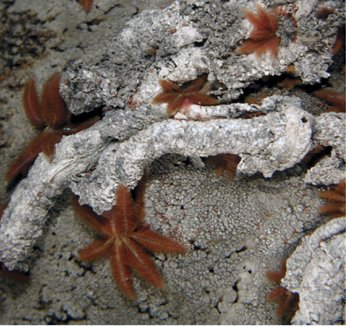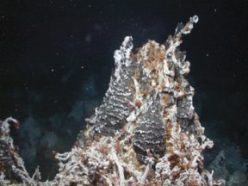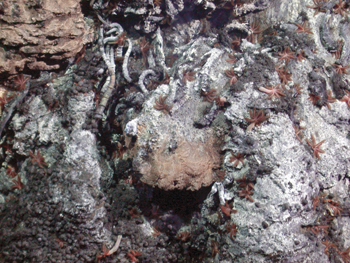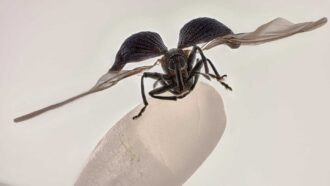Vent worms like it hot
Some undersea worms prefer water at temperatures near the upper limit of what animals are known to survive.
Share this:
- Share via email (Opens in new window) Email
- Click to share on Facebook (Opens in new window) Facebook
- Click to share on X (Opens in new window) X
- Click to share on Pinterest (Opens in new window) Pinterest
- Click to share on Reddit (Opens in new window) Reddit
- Share to Google Classroom (Opens in new window) Google Classroom
- Click to print (Opens in new window) Print
By Emily Sohn
Some worms that live on deep-sea vents can stand temperatures that most other animals on Earth won’t tolerate.
Now, scientists have tested these worms in the lab to find out exactly how hot the worms like it to be. It turns out that the worms prefer water at temperatures near the upper limit of what animals are known to survive.
 |
|
Orange, feathery gills mark the heads of heat-loving worms that live on vents at depths of 2,200 meters off the coast of Washington State.
|
| Image courtesy of Ian McDonald and S. Kim Juniper. |
These tiny worms, called Paralvinella sulfincola, construct tubes as places to live. These tubes, which look a bit like miniature tree trunks lying on their side, sit directly on the hotter zones of underwater, chimney-like crags, where material from inside Earth spews out. Poking their feathery, orange gills out of the tubes, the sulfide worms look like tipped-over palm trees.
Using submersibles with robotic arms, researchers collected some of the worms from 2,200 meters (7,200 feet) deep in the northeastern Pacific.
 |
|
This rocky “tower” at a hydrothermal vent hosts heat-loving sulfide worms, marked by their orange gills.
|
| Image courtesy of William Chadwick, Oregon State University, Monterey Bay Aquarium Research Institute, and NOAA’s Undersea Research Program (NURP). |
In the lab, the scientists put the worms into an aquarium adjusted to copy the high-pressure environment to which the worms are accustomed. There, the creatures were free to move around as much as they wanted.
To test temperature preferences, the researchers heated the aquarium unevenly. One end was 20°C (68°F), which is close to room temperature. The other end was a sweltering 61°C (142°F). At sea level, water boils at 100°C (212°F). The scientists kept track of where the creatures liked to hang out most.
Some of the worms spent 7 hours in an area that was 50°C (122°F). One worm crawled into an area that was 55°C (131°F) and stayed for 15 minutes before moving away. That’s seriously hot.
Even though deep-sea vents are famous for how hot they are, few vent creatures can survive the hottest spots. In a similar experiment, for example, a type of vent shrimp died in the lab at temperatures around 43°C (109°F).
 |
|
In this view looking down on rocks at a deep-sea vent, sulfide worm tubes lie on the rock’s surface, with the worm’s star-shaped gills sticking out the top.
|
| Image courtesy of Peter Girguis and the Monterey Bay Research Institute |
P. sulfincola, it seems, is an exceptional species that provides a new window into the mysterious world of deep-sea vents.
Going Deeper:
Milius, Susan. 2006. Into hot water: Lab test shows that worms seek heat. Science News 169(April 15):228-229. Available at http://www.sciencenews.org/articles/20060415/fob4.asp .
Additional information about experiments with sulfide worms is available at www.aaas.org/news/releases/2006/0414scipak.shtml (American Association for the Advancement of Science).
You can see movies of sulfide worms in a heated, high-pressure aquarium at www.wsu.edu/~rlee/sulfideworm/psulf.html (Washington State University).
Sohn, Emily. 2005. A fallout feast for crabs. Science News for Kids (Jan. 5). Available at http://www.sciencenewsforkids.org/articles/20050105/Note2.asp .
______. 2004. Explorer of the extreme deep. Science News for Kids (Nov. 10). Available at http://www.sciencenewsforkids.org/articles/20041110/Feature1.asp .
______. 2003. Undersea vent system active for ages. Science News for Kids (July 30). Available at http://www.sciencenewsforkids.org/articles/20030730/Note3.asp .







